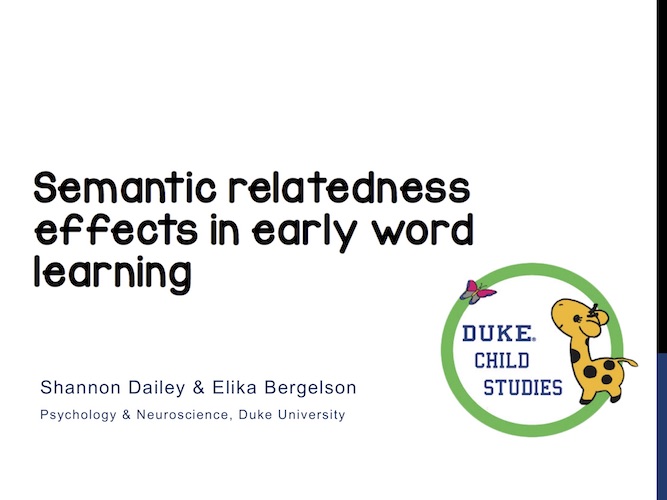Semantic Relatedness Effects in Early Word Learning
Dailey & Bergelson (2017)
Presented at SRCD 2017 in Austin, TX
As part of the symposium: “From input to uptake in early language development: Insights from bigger data,” Chairs - Susan Graham & Mike Frank.
Abstract
Trivially, word comprehension improves over infancy (Bergelson & Swingley, 2012; Dale & Fenson, 1996; Fernald et al, 1998). However, it is unclear what causes improved comprehension with age. One possibility is that the input changes: parents may talk more or differently to older infants, spurring better comprehension. Another possibility is that a gradual accrual of very similar word-learning instances leads to greater comprehension. We use common nouns as a test-case for these two possibilities, combining in-lab eyetracking and corpus analysis in a longitudinal sample (n=44).
We examined word comprehension across semantic contexts (related and unrelated nounpairs), at three time-points (6, 12, and 18 months.) We also analyzed the input statistics of these words in a corpus of monthly day-long audio (n=12 per child) and hour-long video recordings (n=12 per child) of these same children in their home environment. We ask whether (1) in-lab comprehension is modulated by age and semantic relatedness and (2) at-home exposure to the tested words changes month-to-month.
In the eyetracking experiment, infants saw a two-image display. One image was labeled by their parent; parents could not see the screen. Image-pairs were semantically-related (SR, e.g. juice-milk) or semantically-unrelated (SU, e.g. juice-car), with each item occurring in both conditions (32 trials; 16 items.) Comprehension was indexed by the proportion of target looking over a 367-5000ms post-target-onset window, corrected for pre-target-onset looking. A mixed-effects linear model found a main affect of age-group, pre-target looking, and trial-type (all p<.05); an age x trial-type interaction was not justified by model comparison (p>.05; see Figure 1/2). Follow-up tests indicated that 12- and 18-month-olds exhibit abovechance performance in both conditions, and overall, but 6-month-olds only did so in the SU condition, with 23/32 infants attaining positive subjects means (M= .041, p=.013 by Wilcoxon Test; Figures 1-2).
These infants heard the tested words very frequently in our home recordings Infants heard on average 10/16 types (69 tokens) in each daylong audio-recording, and 7/16 types (30 tokens) in each hour-long video. Tested words were heard from ~2 speakers, and were present and attended to 60% of the time. There was no evidence for changing exposure over time (Figure 3).
Together, these results confirm that older infants understand the tested words better than younger infants, and that understanding words in semantically-related visual contexts is more challenging. The complementary corpus results highlight that the input for these words is incredibly stable month-to-month. Infants’ improvement from 6-18 months does not seem to reflect relatively more words over time, more talker-variability, or different exposure conditions (as operationalized here). Rather, improvement seems to stem from an accrual of similar learning instances. This in turn is compatible with two accounts. On a “more data” account, more input leads to greater learning. On a “better learner” account, linguistic, cognitive, and social gains allow older infants to take better advantage of the same kind of data. We explore how to adjudicate between these accounts, to unpack how infants’ input over 6-18 months gives rise to more robust representations of concepts, word-forms, and meaning.
